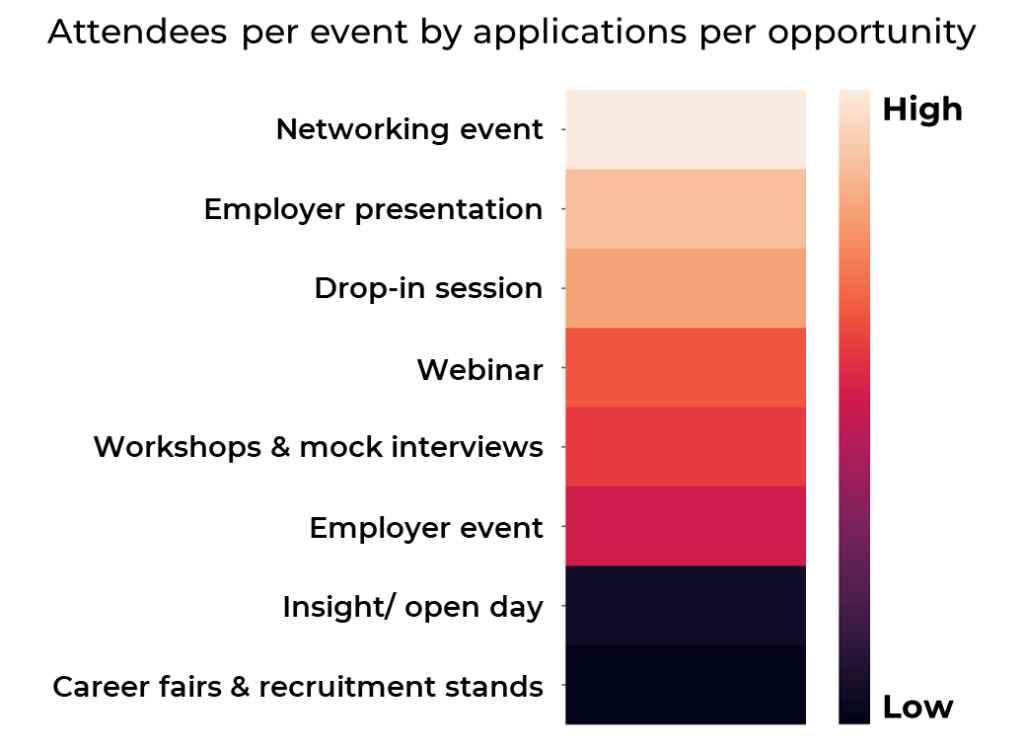Data can help universities better focus their employer engagement efforts, explains Mark Mitchell, Chief Education Partnership Officer at GTI.
To help universities better focus employer engagement efforts we presented data from targetconnect, GTIs career discovery and careers management platform, and our research consultancy Cibyl at the ISE HE Careers Professional Conference.
We compared students stated ambitions with the range and type of opportunities offered to them across the employer spectrum.
What the data tells us
What we found was that there is often a mis-match between the opportunities for employment being served up to students and graduates’ expressed career ambitions (eg sectors or regions of work, type and size of employer).
The good news is that the macro-data shows that graduate jobs are on the rise post-Covid, with a 230% increase in opportunities posted across the targetconnect community when comparing 2022 to 2020.
This has been reflected in a rebound of student confidence. Cibyl data shows that whereas 80% of respondents agreed with the statement ‘It will be tough to get a graduate job next year’ in 2021, in the 2022 survey this had returned to pre-pandemic levels (66%).
However, when we compare sectors of opportunity to students’ location we start to see interesting patterns in supply versus demand (see tracking students’ interest vs reality chart).

Putting the data into practice
Universities can use this data to address imbalances across their unique student cohort and their employer network.
Careers services and employability teams could reach out to their local, regional and national network of employers to target opportunities for their students in under-represented areas.
Alternatively they could initiate targeted communication campaigns to their students to make them aware of opportunities in areas where they may not have previously considered, thus widening their access to opportunity.
Impact of event type on applications
We also looked at the type of career events being run by universities or employers to see if there were similar gaps between student interests and opportunities.
Targetconnect data tracked the volume of applications per opportunity to events and found a broad correlation. Events drive engagement, and a clear positive trend exists between the number of events an employer hosts and the applications they receive per opportunity posted.
Drilling down deeper and looking at the type of events that were driving this engagement produced further insight, as illustrated in the chart ‘events with the biggest return on applications’.

Clearly it is important to understand purpose, intent and audience of events. Careers fairs have greater impact on brand awareness than on direct applications whereas a tailored networking event or presentation can lead to very high levels of applications to open roles, but with a far more concentrated audience.
Having a greater understanding of the type of events that drive applications can help a career team consider where to deploy their resources and how to advise their employers on their engagement strategies with different cohorts of students.
The skills divide
Next we looked at skills, and where potential mis-matches between student confidence and employer requirements might exist.
Targetconnect has a built-in Skills Development module. Analysing data from the 22,000 students who have used this module to assess their skills in 2022, universities can see their students’ confidence and competence (either generally, or split out by cohort) per skills area.
Comparing this data to Cibyl and ISE data on the skills requirements or expectations that employers have, universities can then consider interventions that can support students in areas they feel under-supported.
Equally careers teams can use this insight to create a skills narrative to help students understand the correlation between skills development and employability, and then to help students articulate their skills in this context.
Recommendations
- Student confidence in the job market has returned and they are more selective of their sector interests, meaning attracting candidates is more competitive, although there are sector and regional differences. Helping employers understand regional and sectoral nuances (and mis-matches between student expectation and opportunity access) will help employers attract more relevant candidates and increase student success in the job market.
- Company size makes a difference: medium/large is the most popular across all regions, but the SME sector is also strong (with some sector differences). Advising employers of all sizes how and where they fit into their sector can help improve employer engagement and widen opportunities for students and graduates.
- Students are engaged in their careers service and more events leads to more engagement. Some events drive higher application rates and this can differ across company size. Think about what event type is best for your employers, particularly when looking to bridge opportunity gaps.
- Intent of event is important. Lower return of application events (eg careers fairs) tend to have higher student/employer ratios meaning more competition for attention, but they are impactful for brand awareness. Know when to network and when to boost brand image for the right level of applications.
- In person events are back (after a spike in virtual last year) but employers are using a hybrid approach. In person is preferred by students but virtual is still favoured by some, for different reasons. Make in person events less intimidating and virtual events more engaging for a successful hybrid experience.
- There is a skills gap – student confidences don’t align to employer expectations. These also differ between gender and region. The skills gap is likely to start at subject level, so more emphasis is needed in the curriculum to fill gaps, backing the trend towards experiential learning.
Read more insight and advice for universities


0 Comments